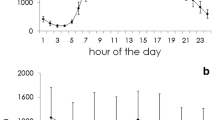Abstract
Tadpoles reduce activity and increase hiding in the presence of dragonfly larvae. Several studies demonstrate that tadpoles showing this behaviour have slower growth, however, other studies have found no effect or even positive growth in tadpoles exposed to predators. A recent study demonstrated that swimming is an energetically expensive activity for Bufo arabicus tadpoles. Therefore, if food resources are abundant close to refuges, reduced activity may be an advantage and could offset the cost of reduced foraging. I tested this hypothesis by growing B. arabicus tadpoles with food provided either near or away from shelters, in the presence or absence of caged dragonfly larvae. In the presence of dragonfly larvae, tadpoles provided with food close to shelters were significantly larger than those with food further away. Control tadpoles under both food treatments were intermediate in size, although not statistically different from the predator + near food tadpoles. The results indicate that access to resources is the main determinant of growth in B. arabicus tadpoles and that the energetic cost of swimming is a secondary factor.



Similar content being viewed by others
References
Barry, M. J., 1994. The costs of crest induction for Daphnia carinata. Oecologia 97: 278–288.
Barry, M. J., 2014a. The energetic cost of foraging explains growth anomalies in tadpoles exposed to predators. Physiological and Biochemical Zoology 87: 829–836.
Barry, M. J., 2014b. Fluoxetine inhibits predator avoidance responses in tadpoles. Toxicological and Environmental Chemistry 96: 641–649.
Barry, M. J. & S. Syal, 2013. Metabolic responses of tadpoles to chemical predation cues. Hydrobiologia 700: 267–276.
Cooper, S. D., L. Barmuta, O. Sarnelle, K. Kratz & S. Diehl, 1997. Quantifying spatial heterogeneity in streams. Journal of the North American Benthological Society 16: 174–188.
Dalton, C. M. & A. S. Flecker, 2014. Metabolic stoichiometry and the ecology of fear in Trinidadian guppies: consequences for life histories and stream ecosystems. Oecologia 176: 1–11.
Fraker, M. E. & B. Luttbeg, 2012. Predator–prey space use and the spatial distribution of predation events. Behaviour 149: 555–574.
Gosner, K. L., 1960. A simplified table for staging anuran embryos and larvae with notes on identification. Herpetologica 16: 183–190.
Hammond, J. I., B. Luttbeg & A. Sih, 2007. Predator and prey use of space: dragonflies and tadpoles in an interactive game. Ecology 88: 1525–1535.
Harvell, C. D., 1990. The ecology and evolution of inducible defenses. Quarterly Review of Biology 65: 323–340.
Hettyey, A., K. Vincze, S. Zsarnóczai, H. Hoi & A. Laurila, 2011. Costs and benefits of defences induced by predators differing in dangerousness. Journal of Evolutionary Biology 24: 1007–1019.
Lass, S. & P. Spaak, 2003. Chemically induced anti-predator defences in plankton: a review. Hydrobiologia 491: 221–239.
Laurila, A., J. Kujasalo & E. Ranta, 1997. Different antipredator behaviour in two anuran tadpoles: effects of predator diet. Behavioral Ecology and Sociobiology 40: 329–336.
Lima, S. L., 1998. Nonlethal effects in the ecology of predator–prey interactions. Bioscience 48: 25–34.
Lima, S. L. & L. M. Dill, 1990. Behavioral decisions made under the risk of predation: a review and prospectus. Canadian Journal of Zoology 68: 619–640.
Lovvorn, J. R. & M. P. Gillingham, 1996. Food dispersion and foraging energetics: a mechanistic synthesis for field studies of avian benthivores. Ecology 77: 435–451.
McCollum, S. A. & J. Van Buskirk, 1996. Costs and benefits of a predator-induced polyphenism in the gray treefrog Hyla chrysoscelis. Evolution 50: 583.
McCollum, S. A. & J. D. Leimberger, 1997. Predator-induced morphological changes in an amphibian: predation by dragonflies affects tadpole shape and color. Oecologia 109: 615–621.
Middlemis, Maher. J., E. E. Werner & R. J. Denver, 2013. Stress hormones mediate predator-induced phenotypic plasticity in amphibian tadpoles. Proceedings of the Royal Society of London Series B 280: 20123075.
Miner, B. G., S. E. Sultan, S. G. Morgan, D. K. Padilla & R. A. Relyea, 2005. Ecological consequences of phenotypic plasticity. Trends in Ecology & Evolution 20: 685–692.
Peacor, S. D., 2002. Positive effect of predators on prey growth rate through induced modifications of prey behaviour. Ecology Letters 5: 77–85.
Relyea, R. A. & J. R. Auld, 2004. Having the guts to compete: how intestinal plasticity explains costs of inducible defences. Ecology Letters 7: 869–875.
Richter-Boix, A., G. A. Llorente & A. Montori, 2007. A comparative study of predator-induced phenotype in tadpoles across a pond permanency gradient. Hydrobiologia 583: 43–56.
Roberts, D., 2014. Rapid habituation by mosquito larvae to predator kairomones. Journal of Vector Ecology 39: 1–6.
Skelly, D. K. & E. E. Werner, 1990. Behavioral and life-historical responses of larval American toads to an odonate predator. Ecology 71: 2313–2322.
Slos, S. & R. Stoks, 2008. Predation risk induces stress proteins and reduces antioxidant defense. Functional Ecology 22: 637–642.
Steiner, U. K. & T. Pfeiffer, 2007. Optimizing time and resource allocation trade-offs for investment into morphological and behavioral defense. The American Naturalist 169: 118–129.
Steiner, U. K. & J. Van Buskirk, 2009. Predator-induced changes in metabolism cannot explain the growth/predation risk tradeoff. PLoS One 4: e6160.
Stein, R. A. & J. J. Magnuson, 1976. Behavioral response of crayfish to a fish predator. Ecology 57: 751–761.
Van Buskirk, J., 2000. The costs of an inducible defense in anuran larvae. Ecology 81: 2813–2821.
Yin, M., C. Laforsch, J. N. Lohr & J. Wolinska, 2011. Predator-induced defense makes Daphnia more vulnerable to parasites. Evolution 65: 1482–1488.
Acknowledgements
The author wishes to acknowledge helpful comments from the two anonymous reviewers and the editor for greatly improving the manuscript. The study was supported by an internal grant from Sultan Qaboos University. All experiments complied with the ethical guidelines of Sultan Qaboos University Animal Ethics Committee.
Author information
Authors and Affiliations
Corresponding author
Additional information
Handling editor: Lee B. Kats
Electronic supplementary material
Below is the link to the electronic supplementary material.
Rights and permissions
About this article
Cite this article
Barry, M.J. Effects of resource distribution on the cost of predator avoidance behaviour in tadpoles. Hydrobiologia 758, 99–105 (2015). https://doi.org/10.1007/s10750-015-2276-3
Received:
Revised:
Accepted:
Published:
Issue Date:
DOI: https://doi.org/10.1007/s10750-015-2276-3




